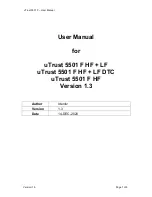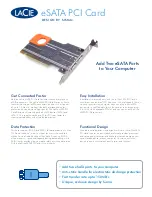
RS-232 Connections/Operation
30
Chapter 7
Document Number 3PCI-0712m
The standard specifies that RS-232 inputs accept voltage levels between
–3 volts and –
25 volts for a Mark (asserted handshake) and b3 volts to +25 volts for a Space
(de-asserted handshake). Typically RS-232 voltages will be b3V to +11V and
–
3V to
–11V.
Handshaking
To control the flow of data between two devices, some software uses hardware
handshaking. RS-232 devices which require hardware handshaking require connection
of RTS/CTS and/or DTR/DSR lines in order to operate properly.
Programs for RS-232 may chose to use only the RS-232 TD and RD data lines and
ignore hardware handshaking inputs (set up as None in the port configuration). In some
cases the software may require connections to verify that a cable is connected and the
devices are ready for access (typically DTR/DSR is used).
Some devices may use software handshaking in which data characters (e.g. Xon/Xoff )
are sent to start and stop the incoming or outgoing data. These unprintable characters
have the decimal value (17) and (19), and can often be generated in a terminal program
with CTL+Q or CTL+S.
RTS Control In RS-232 Mode
In RS-232 mode, MIport cards support software and hardware handshaking.
Handshake lines can be controlled from the communications software used with your
application. When operating a MIport card port in RS-232 mode, set the
RTS Control
driver setting to
Normal
. This ensures that the RTS line will be free to be controlled by
your software. If your communications software uses software handshaking, hardware
handshake lines will not be required.
Figure 13. RTS Control
– Select Normal for RS-232 Operation
Содержание 3PCIOU1
Страница 53: ...Connector Pinouts Document Number 3PCI 0712m Appendix B B 1 Figure 31 2 Wire RS 485 Wiring...
Страница 54: ......
















































